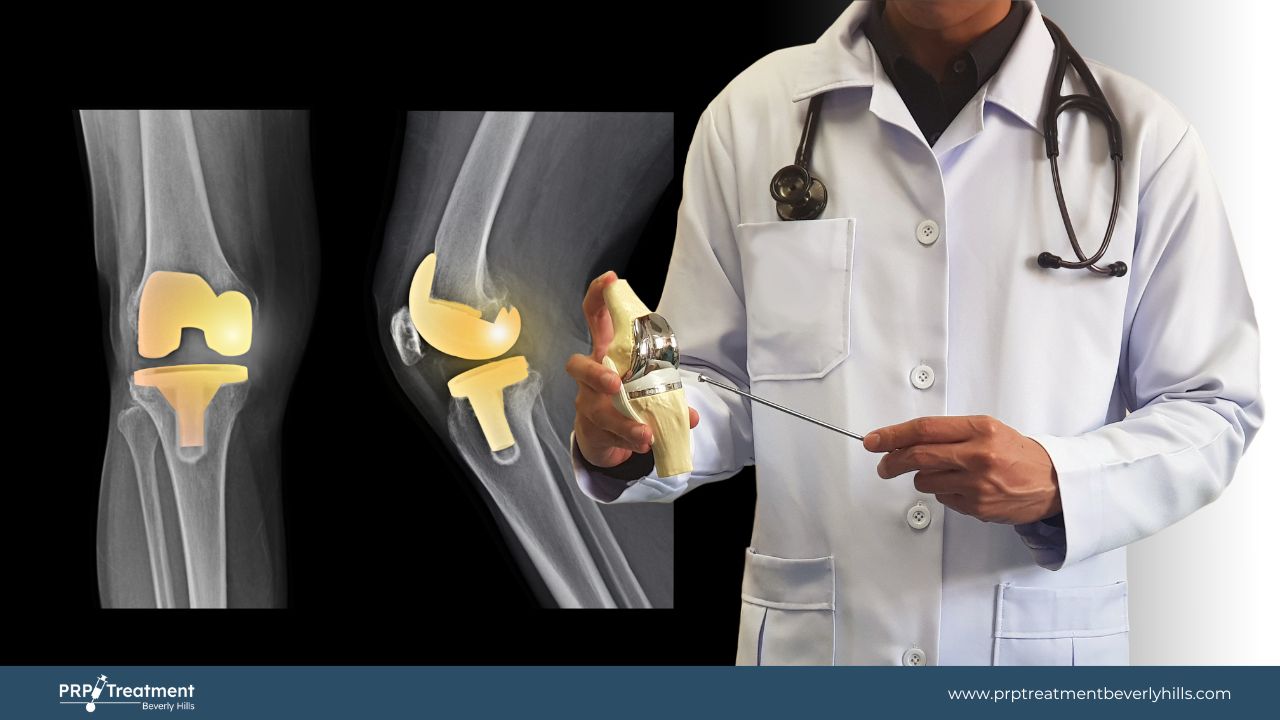Osteoarthritis, a degenerative joint disease, can significantly impact the health and function of your knees. As the cartilage in the joint gradually wears down, many people experience pain, stiffness, and reduced mobility. Platelet-rich plasma (PRP) therapy has emerged as a promising treatment option for those seeking relief from these symptoms.
This comprehensive guide will explore the costs, side effects, and recovery time associated with PRP treatment for knee osteoarthritis, helping you make an informed decision about this innovative therapy.
How PRP Treatment Works for Osteoarthritis of the Knee
PRP treatment injects concentrated platelet-rich plasma into the affected joint in knee osteoarthritis. By introducing a high concentration of growth factors, PRP therapy helps reduce inflammation, stimulate new, healthy tissue growth, and improve joint function.
Recent studies have shown that PRP injections can significantly relieve pain and stiffness and improve joint mobility for knee osteoarthritis patients.
Costs of PRP Treatment for Knee Osteoarthritis
The cost of PRP treatment can vary based on several factors, such as the provider’s experience, the specific treatment protocol, and the location of the practice.
On average, a single PRP injection for knee osteoarthritis can range from $500 to $2,000. Unfortunately, insurance coverage for PRP therapy is not yet widespread, meaning patients may need to cover these costs out of pocket.
When considering PRP treatment, it’s essential to compare these costs with other available treatment options and weigh the potential benefits against the financial investment.
Side Effects of PRP Treatment for Knee Osteoarthritis
PRP therapy is generally considered safe, using the patient’s blood, reducing the risk of allergic reactions or disease transmission. However, as with any medical procedure, there are potential side effects.
Common side effects of PRP injections include mild pain, swelling, and redness at the injection site, which typically subsides within a few days. Less common but more serious complications may include infection, nerve damage, or an adverse reaction to the local anesthetic.
Choosing a qualified healthcare provider with experience administering PRP injections for knee osteoarthritis is crucial to minimize the risk of side effects.
Recovery Time After PRP Injections for Knee Osteoarthritis
Recovery time following PRP treatment can vary depending on the individual and the severity of their condition. Most patients can expect to return to normal activities within a few days to a week after the injection.
Following your healthcare provider’s recommendations for post-injection care is important, such as avoiding strenuous activities and applying ice to the injection site as needed.
To maximize the benefits of PRP treatment, patients should also engage in a comprehensive rehabilitation program, including physical therapy and at-home exercises.
Natural Supplements and PRP Treatment for Knee Osteoarthritis
Various natural supplements have been studied for their potential to alleviate the symptoms of osteoarthritis and support joint health. Some popular supplements include:
Common Natural Supplements for Osteoarthritis
Glucosamine and Chondroitin: These compounds are essential components of cartilage and are believed to help maintain joint structure and function. Studies on their effectiveness have shown mixed results, but some individuals may experience relief from pain and stiffness.
Omega-3 Fatty Acids: In fish and flaxseed oils, omega-3 fatty acids have anti-inflammatory properties that may help reduce joint inflammation and alleviate pain.
Turmeric (Curcumin): Turmeric contains the active compound curcumin, which has potent anti-inflammatory and antioxidant effects. Some studies suggest curcumin may help alleviate osteoarthritis symptoms and improve joint function.
Vitamin D: Adequate vitamin D levels are essential for maintaining bone health and may also play a role in joint health. Some research indicates that low vitamin D levels are associated with an increased risk of osteoarthritis progression.
Combining Supplements and PRP Therapy
Natural supplements alongside PRP treatment may provide a more comprehensive approach to managing knee osteoarthritis. By addressing multiple aspects of joint health, such as inflammation, cartilage integrity, and overall nutritional status, combining these therapies may yield better results than relying on a single treatment modality.
However, discussing your interest in natural supplements with your healthcare provider before starting any new regimen is essential. They can help you determine the most appropriate supplements for your specific needs and ensure they do not interfere with other medications or treatments you may be receiving.
Comparing PRP and Stem Cell Treatment for Knee Osteoarthritis

As you explore the various treatment options for knee osteoarthritis, you may come across another regenerative medicine technique: stem cell therapy.
Like PRP, stem cell treatment aims to promote the body’s natural healing processes, but it does so through stem cells rather than platelets. Understanding the differences between these treatments can help you determine which is more suitable for your specific needs.
Understanding Stem Cell Therapy
Stem cells are unique cells that can transform into various cell types depending on the body’s needs.
In knee osteoarthritis, stem cell therapy involves extracting stem cells from the patient’s bone marrow or adipose (fat) tissue and their subsequent injection into the affected joint.
The goal is to stimulate the growth of new, healthy cartilage and reduce inflammation, ultimately improving joint function.
Comparing Effectiveness and Safety
PRP and stem cell therapies have shown promise in treating knee osteoarthritis, with numerous studies reporting improvements in pain, mobility, and overall joint function. However, more research is needed to determine the long-term effectiveness of these treatments conclusively. Regarding safety, both treatments have relatively low risks, as they utilize the patient’s cells, minimizing the likelihood of adverse reactions or complications.
Cost Comparison
Stem cell treatment is generally more expensive than PRP therapy, with costs ranging from $2,000 to $10,000 per injection, depending on factors such as the provider’s experience, location, and the source of the stem cells.
Like PRP, insurance coverage for stem cell therapy is limited, and patients may need to cover these costs out of pocket.
Choosing the Right Treatment for Your Needs
When deciding between PRP and stem cell treatment for knee osteoarthritis, it’s essential to consider the cost, potential benefits, and any associated risks.
Consult with your healthcare provider to discuss the pros and cons of each treatment option and determine which one may be better suited to your individual needs and circumstances.
The Road to Recovery: Tips for a Speedy Healing Process
To maximize the benefits of PRP treatment and expedite the healing process, follow these recommendations:
- Follow your healthcare provider’s guidelines: Adhere to your provider’s instructions regarding post-injection care, activity restrictions, and any prescribed medications or therapies.
- Apply ice as needed: To reduce pain and inflammation, apply ice packs to the affected area for 15-20 minutes at a time, several times a day, as recommended by your healthcare provider.
- Avoid anti-inflammatory medications: Nonsteroidal anti-inflammatory drugs (NSAIDs), such as ibuprofen, may interfere with the healing process promoted by PRP therapy. Consult your provider before taking any pain-relief medications.
- Limit weight-bearing activities: Give your knee time to heal by avoiding strenuous activities and excessive weight-bearing, especially during the first week or two after the injection.
- Engage in physical therapy: Work with a physical therapist to develop a rehabilitation program tailored to your specific needs, focusing on gentle exercises to improve range of motion, strength, and flexibility.
- Maintain a healthy lifestyle: Promote overall joint health by maintaining a balanced diet, staying hydrated, getting adequate sleep, and managing stress.
- Monitor your progress: Keep track of your symptoms and progress throughout the recovery process, and communicate any concerns or changes to your healthcare provider.
Conclusion
PRP therapy has emerged as a promising and innovative treatment for knee osteoarthritis, offering potential relief from pain, stiffness, and reduced mobility. This comprehensive guide has explored the costs, side effects, recovery time, and the possibility of combining PRP with natural supplements or stem cell therapy for better results.
As you consider your treatment options, consult your healthcare provider about developing a personalized plan tailored to your needs. Ultimately, a holistic approach to managing knee osteoarthritis, including lifestyle changes, rehabilitation, and complementary therapies, will be essential for long-term improvements in joint health and function.



